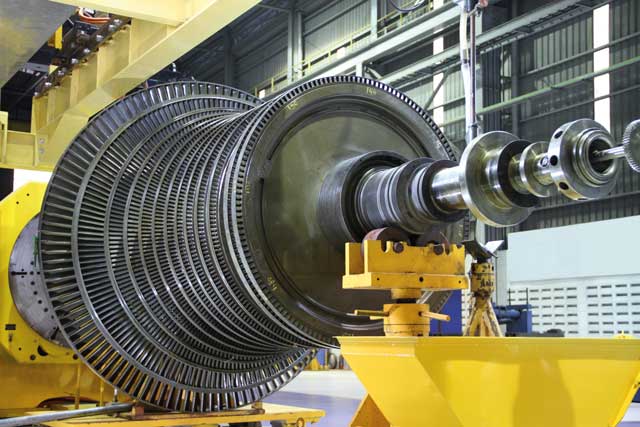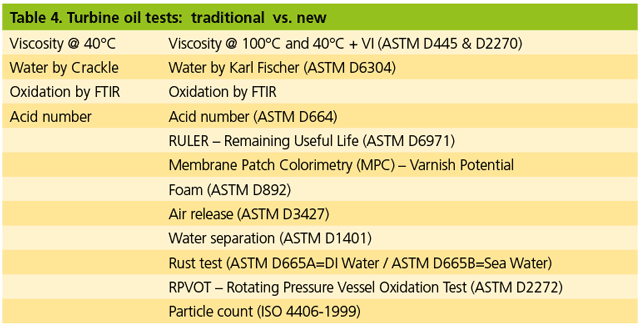 ABSTRACT
ABSTRACT
As the appetite of modern society for electricity continues to grow, so does the desire of power plant managers to increase the reliability of their plants. The main piece of equipment used by power plants to produce electricity is the turbine; if it does not run, the plant does not produce electricity. The most common types used in power plants are gas turbines and steam turbines. Aside from turbine blade failures, the most common turbine reliability problems are bearing and control system failures, which often can be traced back to lubrication-related problems.
A turbine lubrication reliability programme should be an integral part of any power plant maintenance programme. In recent years, significant attention has been given to varnish formation in power turbine lubricating systems. This paper will focus on varnish and other problems seen in steam turbines and will offer suggestions for how operators can overcome them.
Lubrication reliability programme
A lubrication reliability programme for steam turbines must include:
- High-performance lubricant
- Proper installation of new lubricant
- In-service activities
- Purification (contamination control)
- Monitoring
High-performance lubricant
Steam turbines are moneymakers for power plants, making them extremely critical pieces of machinery. It seems like common sense that any turbine operator would choose a high-performance lubricant.
How does one determine the difference between turbine lubricants and hence the right one to use? Low price does not necessarily represent the best value when shopping for steam turbine lubricants. In addition, it is a mistake to focus only on a single performance property when trying to choose the right high-performance turbine oil. Instead, look for a balanced mix of all properties. Table 3 lists the desired properties that should be considered when evaluating steam turbine oils, as well as the benefits of each.

It is possible for steam turbine oil formulations to provide all of the benefits listed in Table 3. The proper components must be chosen, blended and tested to create synergy between the base fluid and the additives. Recent research has shown that any or all of the features listed in Table 3 can be detrimentally affected if the wrong base oil or additives are chosen. For example, some of the performance problems mentioned previously have often been traced back to industry-wide changes in the techniques for refining lubricant base fluid or selecting antioxidant.
Though the lubricant is what will be installed in the steam turbine, it should only be considered part of the product being selected. The product should also come with support services. A good lubricant supplier should be able to provide these, as well as knowledgeable field representation.
A lubricant representative should be able to provide expert advice about turbine oil as well as lubrication reliability recommendations to protect the lubricant when it is in service. This person also should be readily available in times of need. Finally, the turbine operator should verify that the lubricant supplier is able to support the field representative, to answer questions that the representative can’t, and to provide the lubricants and services promised.
When courting potential steam turbine suppliers, it is important to ask a few questions, including:
- Does the oil meet OEM requirements?
- Does the supplier have a formal programme for turbine oil delivery?
- How will the oil be delivered?
- What steps are taken to ensure that the oil is not contaminated during transport?
- What are delivery lead times?
- How does the supplier intend to support the product after installation?
After the OEM approvals have been verified and distribution information gathered from suppliers, the number of acceptable vendors should be dramatically reduced. The next step is to consider oil compatibility and oil vendor services offered to aid in an oil change or addition.
Unless a power plant is being started up for the first time, oil will already be in service in the turbines. The best lubrication practice is to completely drain, clean and refill a steam turbine when changing oils. Unfortunately, this is often impossible because of production and scheduling limitations.
In such cases, it is extremely important that the supplier is capable of providing compatibility testing. If the supplier is unable to provide this service, the power plant should employ a testing lab. If the new oil is found to be incompatible with the oil currently in service in the steam turbine, mixing the oils could lead to more problems than the operator had before the change.
Proper installation of new lubricant
After the oil has been chosen for an oil conversion or oil sweetening, the real work starts. A good lubrication reliability programme should include installation procedures. If a changeover to new oil is not conducted properly, the conversion could provide no benefit, or sometimes make matters worse.
The system must be properly drained and inspected. The steam turbine reservoir should be inspected for sludge and varnish; if it is observed in the reservoir, it is very likely that it is present in the pumps and piping in the oil circulating system. The operator must clean the turbine or – if lacking the expertise – hire a professional firm to do it.
It is vital that the turbine is properly cleaned and flushed prior to addition of the new lubricant; otherwise, when the new lubricant is dispensed, it can churn up any varnish and sludge present in the system. In this case, worse oil performance can result.
In-service activities
An effective lubrication reliability programme for steam turbines must include preventive maintenance activities, including purification and condition monitoring.
Oil purification (contamination control)
Removal
To obtain maximum performance from a steam turbine and the turbine oil contained within, it is important to remove any contamination that might be present or introduced into the oil. Contamination can be the catalyst of oil degradation, which results in reduced reliability of the turbine. Some OEMs will supply purification systems with the turbine during the installation, but depending on the age of the turbine or the contaminant to be removed, it may not be best for the intended job.
The term purification can be representative of various oil cleaning techniques, depending on the contaminant to be removed. For removing water, the most common purification devices are called separators.
Separators for removal of water from steam turbine systems include these various types:
- Gravity
- Centrifugal
- Coalescing
- Absorbent polymer
- Vacuum distillation
To remove other contaminants, such as solid and soft contaminants, the main purification technique is filtration. Filtration types are defined as primary and secondary. Primary systems are often called inline filtration systems. Secondary systems, frequently used in conjunction with primary systems, are often called kidney-loop filtration systems. Primary filtration requires high oil throughput, and so is not usually as effective as primary and secondary systems used together. Secondary systems are used to filter the oil separately from the bearings in the turbine. Primary and secondary filter systems use similar media.
Common filter media include:
- Cartridge-type, containing paper, glass fibre or synthetic polymers
- Depth filtration using roll-type paper or particulate solids, such as clay
- Electrostatic
- Ion-exchange media
Prevention
Contamination can also be controlled by preventing it from getting into the steam turbine from the start. Several techniques have been used to accomplish this. A common one is air filtration; another is controlled air addition to the system.
A common air filtration device is the desiccant breather. Outside air is drawn through it on its way into the steam turbine oil system. The breather removes both water vapour and dirt from the air so that these contaminants do not infiltrate the oil.
In controlled air addition, the technique is to push a positive pressure of either dry air or an inert gas, such as nitrogen, into the steam turbine oil system. The positive pressure in the system keeps contaminated air from entering.
Oil condition monitoring
After high-quality oil is installed in a steam turbine and high-performance purification equipment is employed, a monitoring programme must be instituted to evaluate the condition of the oil. Whole papers have been written on the subject of oil analysis, but – as a brief overview – an effective oil analysis programme should include four main activities:
- Test selection
- Lab selection
- Establishment of action limits
- Use of the report.
The main task for the turbine operator trying to establish an oil analysis programme is to determine the tests that should be run. Unfortunately, many commercial laboratories have simplified their programmes to provide test packages based on very broad categories, such as industrial oil analysis or engine oil analysis. The trouble with these test programmes is that they can often include tests that are unnecessary, or miss tests that may be critical to the specific application of interest.
There are specific tests that should be considered for proper evaluation of steam turbine oil. Table 4 provides a list of traditional tests routinely employed for industrial oils at commercial labs compared with a list of tests that should be considered, with specific choices dependent upon the current operation of the turbine.

 John A. Sander,
John A. Sander,
Vice President of
Research & Development,
Lubrication Engineers, Inc.

